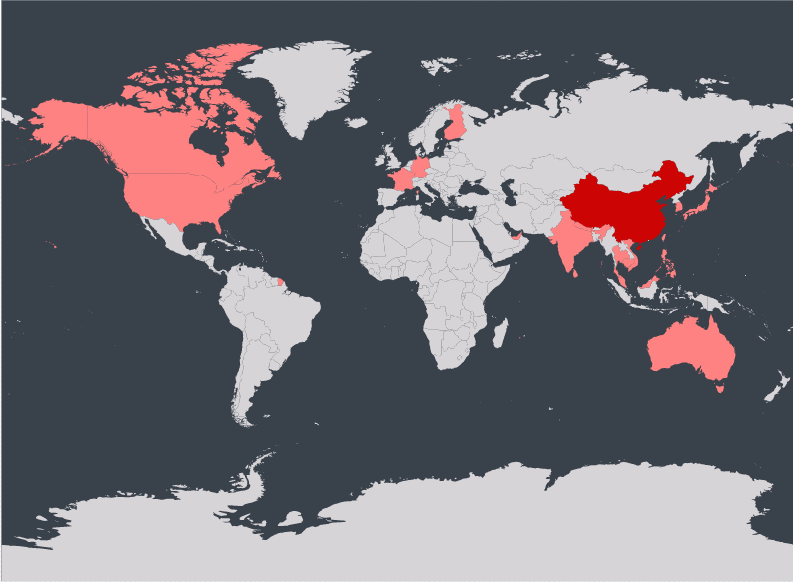Last Updated on September 6, 2025 by Muhamed Elmesery
In the past few days, there has been a lot of news about the new coronavirus, which appeared in Wuhan, the capital of Hubei Province in China. China announced the first infection with the new coronavirus on the 30th of last December. And then the announcements continued to be about more cases of infection in several countries around the world according to the following map from Sky News:

There have been conflicting claims about the causes of this virus, its severity, and how to prevent it. Therefore, in this article, PraxiLabs will provide you with a quick idea about the biology of viruses in general. Then we address the most important reports from health organizations around the world regarding this virus in particular.
Pick The Best Virtual Plan for You
Table of Contents
Viruses:
Viruses are microscopic infectious agents that can reproduce by controlling the cells of living organisms. Then they use their components to manufacture more viruses. Thus, they are not considered living organisms since they need a host in order to reproduce and don’t have cells as their size is very small compared to the cells of living organisms.
Although they are not classified as living organisms, they also cannot be classified as non-living because they possess some of the characteristics of the cells of living organisms, such as DNA and RNA, which contain the genetic characteristics just like living organisms and have the ability to evolve.

The forms of the virus could vary between spherical and bacillus viruses, but they are also classified according to the cells that host them. So there are animal viruses that attack animals only, plant ones that attack plants only, and human ones that attack humans only. Moreover, there are some types of mixed viruses that can infect humans and animals, such as avian influenza, swine influenza, rabies, yellow fever, and parrot fever.
Coronavirus:
New Coronavirus belongs to the family of coronaviridae which are positive-sense, single-stranded RNA viruses.
RNA is defined as a vital part that exists in almost all living organisms and viruses. It also plays multiple roles in transferring, coding, decoding, and regulating the genetic information and stimulating many chemical reactions. By extracting and studying the virus’s RNA (RNA extraction), scientists can understand more and more information about the virus and its evolution.
In this video, you will watch the RNA extraction experiment using the Virtual Biology Lab from PraxiLabs.
Coronaviruses infect mammals, including humans and birds. Coronavirus infects humans in the respiratory system and is often a slight infection, not dangerous, and it is rarely fatal. There are no approved vaccines or antivirals for the prevention or treatment of these viruses yet.
New Coronavirus:
After the emergence of the first cases infected with the new Coronavirus in China where scientists were able to identify and classify it, the Chinese authorities announced that this virus belongs to the Coronavirus family. Coronaviruses are classified into six types that infect humans so far, and with the emergence of this new type, they became seven types. One of the most dangerous viruses of these types was the acute respiratory syndrome (SARS), which killed 774 people after infecting more than 8,000 people, as it spread to most Asian countries, originating from China in 2002.

According to the BBC, Josie Goulding, a member of the Welcome Trust Organization, stated that “SARS remains stuck in our minds strongly to this day, and I think this is the source of growing fear, but we are now more prepared to combat these types of diseases.”
Try 3D Virtual Labs Now for Free
But does the new Coronavirus pose a real threat like SARS? According to one of the articles published in the journal “JAMA”, the first signs of this virus are somewhat reassuring. As after the emergence of the first severe cases less severe cases also appeared, which means that the spread of the virus and the response to it by the human body are less than that in the case of SARS’, which killed 11% of the infected people, while the new virus has killed only 4% of cases to date.
Also, most of the deaths caused by the new virus were for the elderly people over the age of 50, and this is in contrast to SARS, where the average lifespan of deaths was 40 years.
On January 30th, the World Health Organization declared a state of emergency and recommended the importance of circulating information between countries in a high degree of neutrality and accuracy, as there were concerns about obfuscating or issuing incorrect data with the aim of misleading citizens to mitigate the event for them.
Try the PCR Analysis simultion in Praxilabs’ virtual labs
How Did the New Coronavirus Appear?
Different types of new viruses are constantly being discovered, and the infection often passes to humans from other organisms, without feeling it.
“If we look at the spread of viruses in the past, and if this is a new member of the Coronavirus family, it is likely that they have passed from a virus-carrying animal,” said Jonathan Paul, Professor of Virology at the University of Nottingham. As SARS virus appeared and was transmitted to humans from the bats. And MERS virus was passed on to humans from camels and killed 858 people, while the number of infected people reached 2494.
Symptoms of the New Coronavirus:
Symptoms of New Coronavirus infection include feeling
- Shortness of breath.
- Fever.
- Cough.
- A headache.
- Symptoms may develop into pneumonia.
Prevention of New Coronavirus:
Keep washing your hands with soap and water frequently, especially after being in crowded places, avoid touching the nose, mouth, and eyes frequently, and avoid direct contact with infected people or sharing their tools. Also, avoid being in known places of infection, and avoid being in the vicinity of animals’ markets.
Treating the New Coronavirus:
To the time of posting this article, there are no new vaccines for the newly discovered virus and no medicines to treat it, but researchers are now working extensively on developing vaccines and medicines for the virus. It is hoped that the researches that had been done to the development of an anti-MERS vaccine, also from the Coronavirus family, make this task easier. Hospitals are also testing antivirals already available to find out if any of them can treat this virus.
PraxiLabs Virtual Labs include a range of 3D science experiments in physics, chemistry and biology experiments
 PraxiLabs A virtual world of science
PraxiLabs A virtual world of science






